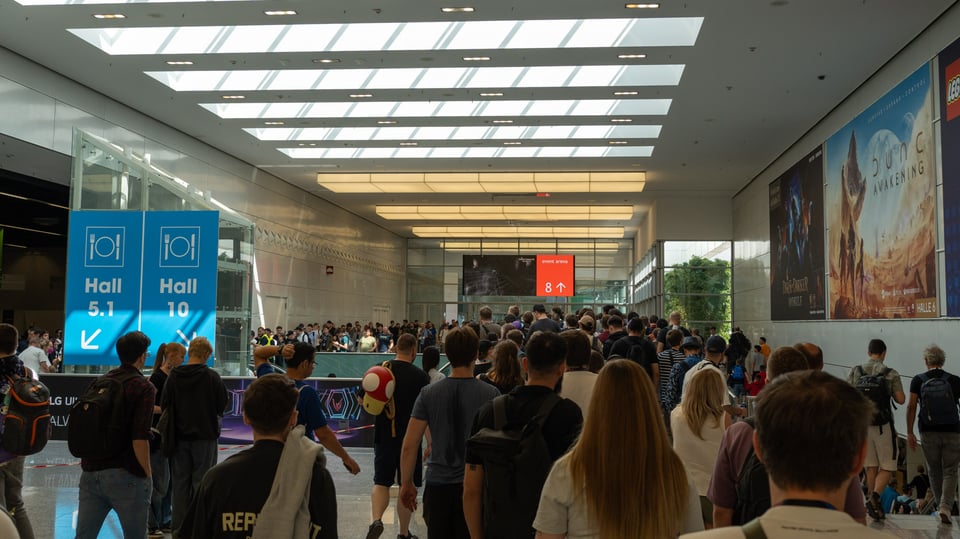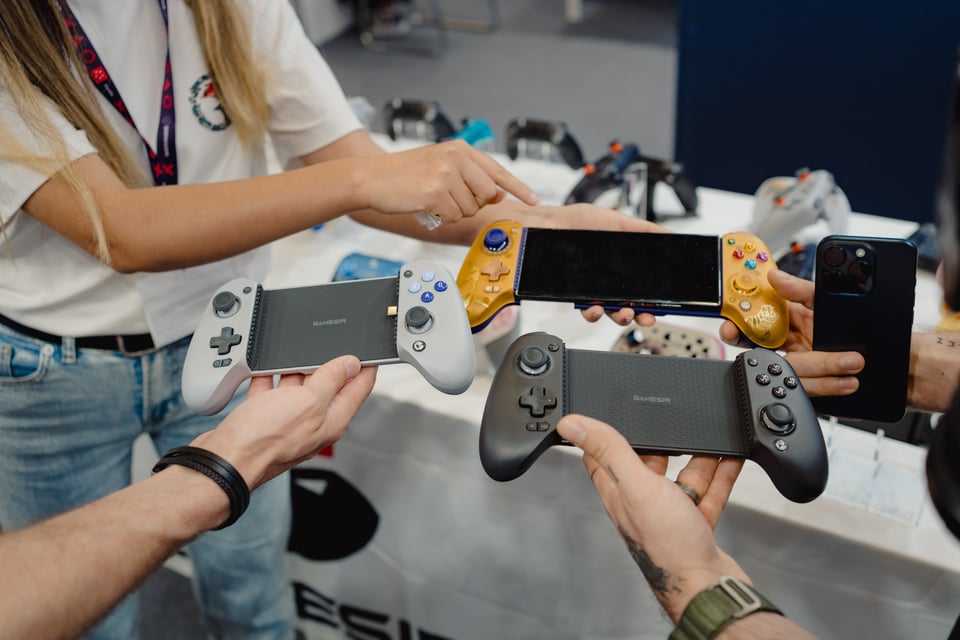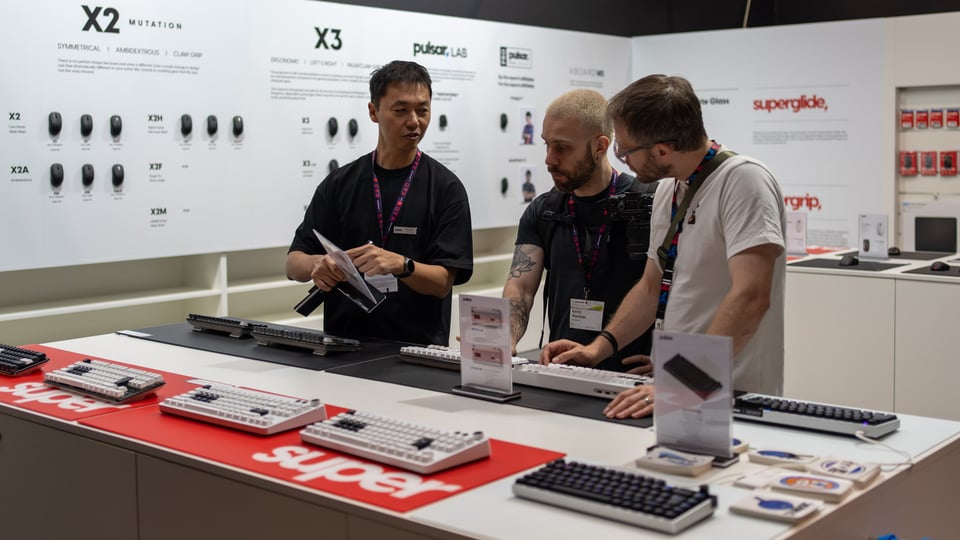Gamescom Day 2: Clicky Clicky
Hallo, and welcome to our third daily newsletter direct from Cologne, Germany. We’ve spent another day trawling the show floor, and meeting developers.
Today was the first day the public could come to the exhibition, and let me tell you, it was madness. People were queueing up everywhere: to get into Gamescom, at basically every game booth, at the food courts, and at the restrooms.

If you’re coming to Gamescom, you need to be patient! Tomorrow might be even worse. The organisers are expecting nearly 300,000 visitors by the weekend. 🤯
Now, after another day of roughly 20,000 steps, we’re in the hotel bar ready to bring you the highlights. Let’s get to it.
Kevin Wammer: The day started with hardware, as we passed the Gamesir booth — known for their smartphone grips. We’ve mentioned similar grips on overkill before (I personally use the Razer Kishi and the Backbone One), but this was the first time I was able to test Gamesir’s offerings after hearing Russ from Retrogamecorps talk positively about them. From the short hands-on time we had, these definitely feel like a solid option, especially considering their lower price.
Chris Brandrick: Yep, they had a decent range of devices, including some themed options (such as Marvel) if that’s your bag. I was curious if any of these devices would fit an iPad Mini — as I’m keen to try using mine as an Apple Arcade machine — and sure enough, a few of Gamesir’s products would work well with the lil tablet. I’m going to investigate further as to the viability of the iPad Mini as a way to really get the best from Apple’s gaming service.

Kevin Wammer: However, it didn’t end there, as we later were invited by established accessory manufacturer PowerA to take a look at their new offerings. PowerA is one of the bigger players in the space now, especially since they are a licensed accessory maker for companies like Sony, PlayStation and Nintendo.
But following success in the console space, PowerA now wants to grow in the PC accessory market by unveiling two (and a half) new products: the PowerA OPS v3 and the budget-friendly OPS v1.
But while it’s a budget-friendly controller, the PowerA OPS v1 still has features that I usually only see in higher-end products: the OPS v1 comes with hall-sensing analogue sticks and triggers, a 20h battery, four mappable backpedals, a programmable turbo button, and it can connect to any PC via Bluetooth, wired or a low-latency 2.4GHz wireless connection (through an adapter). There’s also a Fortnite version of the controller, which even gives you an in-game item in the form of an Assault Bomber Glider (I don’t know what this means). You can get the OPS v1 for $49.99 and it will ship in early September.

The OPS v3 goes one step further, and in addition to what I’ve just mentioned also adds tactical mechanical switches for the D-Pad, face buttons and shoulder buttons. I’m a big fan of mechanical switches (in controllers, mice or keyboards) and these felt great. They were incredibly satisfying to click.
Chris Brandrick: Kevin didn’t stop clicking them, so if you love a clicky keyboard you’ll love this.
Kevin Wammer: Additionally, you can adjust the height of the thumbsticks found on the OPS v3 by simply twisting them. Finally, it features two more mappable buttons next to the shoulder buttons, comes with a charging stand, and has novel multi-zone RGB lighting, all with 30 hours of battery life. The price for the OPS v3 is $99.99, and I’m planning to grab one for my controller collection.
Kevin Wammer: While we’re on the topic of clicky switches: by chance we stumbled upon the Pulsar booth. Pulsar is a South Korean esports manufacturer that works on keyboards, mice, mouse pads, and related accessories for esports gamers (like arm sleeves).
I’d not heard of the company before today, which is why I was even more surprised to see the sheer level of quality these guys bring to the market. They have a whole range of beautiful keyboards, including some featuring hall-sensing key switches. Just look at this beauty.

Hall-sensing key switches are especially interesting to gamers. Since they use magnets to register their inputs, you can customise the actuation point to your liking, resulting in much faster response times. They even allow features that some might consider cheating, including Valve as they’ve recently banned some of these capabilities in Counter-Strike. (Though the use of hall-sensing key switches itself is not considered cheating, it’s only when you combine it with automation.)

I think I might need to add a few of their products to my shopping list.
Chris Brandrick: On the software side of things, we spent some time checking out Forgotten Fragments today — an upcoming puzzle platformer that’s been in development for some six years now. It was born at a game jam, and since then has been the side project of a team of just two.
At first glance, you may think that a game such as Celeste is an inspiration here, but developer Pol Monforte was keen to stress otherwise, instead pointing to the likes of Portal 2. The 2D adventure sees you take on a series of platforming rooms, with puzzles to solve via interacting with boxes, orbs and the like.
The team of two are continuing to work on the game, but couldn’t offer a firm release date beyond ‘2025’. Due to the nature of this impressive platformer being a side project, it will be done, when it’s done — refreshing.
Thankfully you don’t have to wait to give it a spin, as there’s already a demo up on Steam. We tried the game on the Steam Deck, and this is shaping up to be a fun one to kick back on the sofa with and tackle a few of the 60+ puzzles.
And that’s it for today’s newsletter. Tomorrow will be our busiest day, so we’re heading straight to bed.
Tschüss, bis morgen!